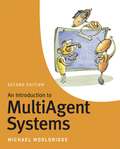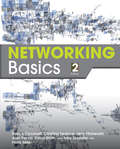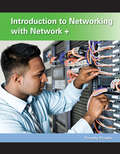- Table View
- List View
An Introduction to Modern Mathematical Computing: With Maple™ (Springer Undergraduate Texts in Mathematics and Technology)
by Jonathan M. Borwein Matthew P. SkerrittThirty years ago mathematical, as opposed to applied numerical, computation was difficult to perform and so relatively little used. Three threads changed that: the emergence of the personal computer; the discovery of fiber-optics and the consequent development of the modern internet; and the building of the Three “M’s” Maple, Mathematica and Matlab. We intend to persuade that Maple and other like tools are worth knowing assuming only that one wishes to be a mathematician, a mathematics educator, a computer scientist, an engineer or scientist, or anyone else who wishes/needs to use mathematics better. We also hope to explain how to become an `experimental mathematician' while learning to be better at proving things. To accomplish this our material is divided into three main chapters followed by a postscript. These cover elementary number theory, calculus of one and several variables, introductory linear algebra, and visualization and interactive geometric computation.
An Introduction to Modern Mathematical Computing: With Mathematica® (Springer Undergraduate Texts in Mathematics and Technology)
by Jonathan M. Borwein Matthew P. SkerrittThirty years ago mathematical, as opposed to applied numerical, computation was difficult to perform and so relatively little used. Three threads changed that: the emergence of the personal computer; the discovery of fiber-optics and the consequent development of the modern internet; and the building of the Three “M’s” Maple, Mathematica and Matlab.We intend to persuade that Mathematica and other similar tools are worth knowing, assuming only that one wishes to be a mathematician, a mathematics educator, a computer scientist, an engineer or scientist, or anyone else who wishes/needs to use mathematics better. We also hope to explain how to become an "experimental mathematician" while learning to be better at proving things. To accomplish this our material is divided into three main chapters followed by a postscript. These cover elementary number theory, calculus of one and several variables, introductory linear algebra, and visualization and interactive geometric computation.
Introduction to Modern Number Theory: Fundamental Problems, Ideas and Theories (Encyclopaedia of Mathematical Sciences #49)
by Yu. I. Manin Alexei A. PanchishkinThis edition has been called ‘startlingly up-to-date’, and in this corrected second printing you can be sure that it’s even more contemporaneous. It surveys from a unified point of view both the modern state and the trends of continuing development in various branches of number theory. Illuminated by elementary problems, the central ideas of modern theories are laid bare. Some topics covered include non-Abelian generalizations of class field theory, recursive computability and Diophantine equations, zeta- and L-functions. This substantially revised and expanded new edition contains several new sections, such as Wiles' proof of Fermat's Last Theorem, and relevant techniques coming from a synthesis of various theories.
An Introduction to Modern Timekeeping and Time Transfer (Springer Series in Measurement Science and Technology)
by Parameswar Banerjee Demetrios MatsakisThis book provides a comprehensive, systematic description of modern timekeeping and its specializations. Introductory chapters discuss the concept of time and its definition, then briefly look at pre-Atomic Era timekeeping to set the stage for the introduction of the atomic clock. Subsequent chapters focus on concepts such as frequency stability and measurement uncertainty, as well as computer network time-synchronization protocols including Network Time Protocol (NTP) and Precise Time Protocol (PTP). The book then delves into the nuts and bolts of the Global Navigation Satellite Systems (GNSS), Two-Way Satellite Time and Frequency Transfer, and Optical Time and Frequency Transfer. Timescale theory is then described as a way to combine clock data, and the algorithms and procedures used to generate Coordinated Universal Time (UTC) are given. Finally, there is a look at modern applications of timekeeping and time transfer.Featuring a glossary of all key terms, this book is highly recommended for trained or incoming physicists, engineers, or mathematicians working, for example, in manufacturing or timing laboratories. Additionally, it is suitable for use in introductory university courses dealing with the subject of timekeeping.
Introduction to Morphogenetic Computing (Studies in Computational Intelligence #703)
by Germano Resconi Xiaolin Xu Guanglin XuThis book offers a concise introduction to morphogenetic computing, showing that its use makes global and local relations, defects in crystal non-Euclidean geometry databases with source and sink, genetic algorithms, and neural networks more stable and efficient. It also presents applications to database, language, nanotechnology with defects, biological genetic structure, electrical circuit, and big data structure. In Turing machines, input and output states form a system – when the system is in one state, the input is transformed into output. This computation is always deterministic and without any possible contradiction or defects. In natural computation there are defects and contradictions that have to be solved to give a coherent and effective computation. The new computation generates the morphology of the system that assumes different forms in time. Genetic process is the prototype of the morphogenetic computing. At the Boolean logic truth value, we substitute a set of truth (active sets) values with possible contradictions. The value of a proposition is a set of true and false values. The aim of morphogenetic computing is to use and solve the contradictions in order to transform systems to allow classical computation.
An Introduction to MultiAgent Systems
by Michael WooldridgeThe eagerly anticipated updated resource on one of the most important areas of research and development: multi-agent systems Multi-agent systems allow many intelligent agents to interact with each other, and this field of study has advanced at a rapid pace since the publication of the first edition of this book, which was nearly a decade ago. With this exciting new edition, the coverage of multi-agents is completely updated to include several areas that have come to prominence in the last several years, including auctions, computational social choice, and markov decision processes. In turn, a variety of topics that were initially considered critical have dwindled in importance, so the coverage of that subject matter is decreased with this new edition. The result of this redefined balance of coverage is a timely and essential resource on a popular topic. Introduces you to the concept of agents and multi-agent systems and the main applications for which they are appropriate Discusses the main issues surrounding the design of intelligent agents and a multi-agent society Delves into a number of typical applications for agent technology Addresses deductive reasoning agents, practical reasoning agents, reactive and hybrid agents, and more Reviews multi-agent decision making, communication and cooperation, and intelligent autonomous agents By the end of the book, you will have a firm grasp on how agents are distinct from other software paradigms and understand the characteristics of applications that lend themselves to agent-oriented software.
An Introduction to Narrative Generators: How Computers Create Works of Fiction
by Rafael Pérez y Pérez Mike SharplesThis book describes how computer programs can generate narratives and how studies of computational narrative can illuminate how humans tell stories. Combining an introduction to relevant concepts related to automatic storytelling with accessible descriptions of well-known computer programs that illustrate how such concepts are employed, the book is aimed at an interdisciplinary audience and assumes little or no background in computer science. The book introduces the most relevant techniques employed over the last 60 years for the development of computer models for narrative generation, including narrative templates, problem-solving, planning, author engagement and reflection, and statistical methods such as deep neural networks, ending with an examination of the societal implications of the development of automatic narrative generator systems.
An Introduction to Network Programming with Java: Java 7 Compatible
by Jan GrabaSince the second edition of this text, the use of the Internet and networks generally has continued to expand at a phenomenal rate. This has led to both an increase in demand for network software and to improvements in the technology used to run such networks, with the latter naturally leading to changes in the former. During this time, the Java libraries have been updated to keep up with the new developments in network technology, so that the Java programming language continues to be one of the mainstays of network software development.In providing a very readable text that avoids getting immersed in low-level technical details, while still providing a useful, practical guide to network programming for both undergraduates and busy IT professionals, this third edition continues the trend of its predecessors. To retain its currency, the text has been updated to reflect changes that have taken place in Java's network technology over the past seven years (including the release of Java 7), whilst retaining its notable features of numerous code examples, screenshots and end-of-chapter exercises.
An Introduction to Network Programming with Java
by Jan GrabaThe 1st edition of this book was equally useful as an undergraduate textbook and as the lucid, no-nonsense guide required by IT professionals, featuring many code examples, screenshots and exercises. The new 2nd edition adds revised language reflecting significant changes in J2SE 5.0; update of support software; non-blocking servers; DataSource interface and Data Access Objects for connecting to remote databases.
Introduction to Network Security (Chapman And Hall/crc Computer And Information Science Ser.)
by Douglas JacobsonUnlike data communications of the past, today's networks consist of numerous devices that handle the data as it passes from the sender to the receiver. However, security concerns are frequently raised in circumstances where interconnected computers use a network not controlled by any one entity or organization. Introduction to Network Security exam
Introduction to Network Security: Theory and Practice
by Jie Wang Zachary A. KisselIntroductory textbook in the important area of network security for undergraduate and graduate students Comprehensively covers fundamental concepts with newer topics such as electronic cash, bit-coin, P2P, SHA-3, E-voting, and Zigbee security Fully updated to reflect new developments in network security Introduces a chapter on Cloud security, a very popular and essential topic Uses everyday examples that most computer users experience to illustrate important principles and mechanisms Features a companion website with Powerpoint slides for lectures and solution manuals to selected exercise problems, available at http://www.cs.uml.edu/~wang/NetSec
Introduction to Network Security: Theory and Practice
by Jie Wang Zachary A. KisselIntroductory textbook in the important area of network security for undergraduate and graduate students Comprehensively covers fundamental concepts with newer topics such as electronic cash, bit-coin, P2P, SHA-3, E-voting, and Zigbee security Fully updated to reflect new developments in network security Introduces a chapter on Cloud security, a very popular and essential topic Uses everyday examples that most computer users experience to illustrate important principles and mechanisms Features a companion website with Powerpoint slides for lectures and solution manuals to selected exercise problems, available at http://www.cs.uml.edu/~wang/NetSec
Introduction to Network Simulator NS2
by Teerawat Issariyakul Ekram HossainIntroduction to Network Simulator NS2 is a primer providing materials for NS2 beginners, whether students, professors, or researchers for understanding the architecture of Network Simulator 2 (NS2) and for incorporating simulation modules into NS2. The authors discuss the simulation architecture and the key components of NS2 including simulation-related objects, network objects, packet-related objects, and helper objects. The NS2 modules included within are nodes, links, SimpleLink objects, packets, agents, and applications. Further, the book covers three helper modules: timers, random number generators, and error models. Also included are chapters on summary of debugging, variable and packet tracing, result compilation, and examples for extending NS2. Two appendices provide the details of scripting language Tcl, OTcl and AWK, as well object oriented programming used extensively in NS2.
Introduction to Network Simulator NS2
by Teerawat Issariyakul Ekram HossainAn Introduction to Network Simulator NS2 is a beginners’ guide for network simulator NS2, an open-source discrete event simulator designed mainly for networking research. NS2 has been widely accepted as a reliable simulation tool for computer communication networks both in academia and industry. This book will present two fundamental NS2 concepts:i) how objects (e.g., nodes, links, queues, etc.) are assembled to create a network and ii) how a packet flows from one object to another. Based on these concepts, this book will demonstrate through examples how new modules can be incorporated into NS2. The book will: -Give an overview on simulation and communication networks. -Provide general information (e.g., installation, key features, etc.) about NS2. -Demonstrate how to set up a simple network simulation scenario using Tcl scripting lanuage. -Explain how C++ and OTcl (Object oriented Tcl) are linked, and constitute NS2. -Show how Ns2 interprets a Tcl Script and executes it. -Suggest post simulation processing approaches and identify their pros and cons. -Present a number of NS2 extension examples. -Discuss how to incorporate MATLAB into NS2.
Introduction to Networking Basics
by Alan Dennis Frank Miller Toby Skandier Patrick Ciccarelli Christina Faulkner Jerry FitzGerald David GrothThe 2nd edition of Wiley Pathways Networking Basics addresses diversity and the need for flexibility. Its content focuses on the fundamentals to help grasp the subject with an emphasis on teaching job-related skills and practical applications of concepts with clear and professional language. The core competencies and skills help users succeed with a variety of built-in learning resources to practice what they need and understand the content. These resources enable readers to think critically about their new knowledge and apply their skills in any situation.
Introduction to Networking with Network+
by Timothy PintelloIntroduction to Networking with Network + is the cornerstone for your networking curriculum. It is built around the new Network+ 2012 framework. It is based upon the CompTIA Network+ certification and covers the most recent exam objectives. Are you tired of books that cover new technologies and exam topics in a fleeting fashion, and are bogged down with legacy technology coverage that is now out-dated? This book by Timothy Pintello is up-to-date and covers only relevant and current technologies. This book also includes his revolutionary method for making Subnetting easily understood by new IT students.
An Introduction to Neural Information Processing
by Peiji Liang Si Wu Fanji GuThis book provides an overview of neural information processing research, which is one of the most important branches of neuroscience today. Neural information processing is an interdisciplinary subject, and the merging interaction between neuroscience and mathematics, physics, as well as information science plays a key role in the development of this field. This book begins with the anatomy of the central nervous system, followed by an introduction to various information processing models at different levels. The authors all have extensive experience in mathematics, physics and biomedical engineering, and have worked in this multidisciplinary area for a number of years. They present classical examples of how the pioneers in this field used theoretical analysis, mathematical modeling and computer simulation to solve neurobiological problems, and share their experiences and lessons learned. The book is intended for researchers and students with a mathematics, physics or informatics background who are interested in brain research and keen to understand the necessary neurobiology and how they can use their specialties to address neurobiological problems. It is also provides inspiration for neuroscience students who are interested in learning how to use mathematics, physics or informatics approaches to solve problems in their field.
An Introduction to Neural Networks
by Kevin GurneyThough mathematical ideas underpin the study of neural networks, the author presents the fundamentals without the full mathematical apparatus. All aspects of the field are tackled, including artificial neurons as models of their real counterparts; the geometry of network action in pattern space; gradient descent methods, including back-propagation; associative memory and Hopfield nets; and self-organization and feature maps. The traditionally difficult topic of adaptive resonance theory is clarified within a hierarchical description of its operation. The book also includes several real-world examples to provide a concrete focus. This should enhance its appeal to those involved in the design, construction and management of networks in commercial environments and who wish to improve their understanding of network simulator packages. As a comprehensive and highly accessible introduction to one of the most important topics in cognitive and computer science, this volume should interest a wide range of readers, both students and professionals, in cognitive science, psychology, computer science and electrical engineering.
Introduction to Neural Networks
by P.D. PictonThis book introduces neural networks. It describes what they are, what they can do and how they do it. While some scientific background is assumed, the reader is not expected to have any prior knowledge of neural networks. These networks are explained and discussed by means of examples, so that by the end of the book the reader will have a good overall knowledge of developments right up to current work in the field.
Introduction to Neuro-Fuzzy Systems (Advances in Intelligent and Soft Computing #2)
by Robert FullerFuzzy sets were introduced by Zadeh (1965) as a means of representing and manipulating data that was not precise, but rather fuzzy. Fuzzy logic pro vides an inference morphology that enables approximate human reasoning capabilities to be applied to knowledge-based systems. The theory of fuzzy logic provides a mathematical strength to capture the uncertainties associ ated with human cognitive processes, such as thinking and reasoning. The conventional approaches to knowledge representation lack the means for rep resentating the meaning of fuzzy concepts. As a consequence, the approaches based on first order logic and classical probablity theory do not provide an appropriate conceptual framework for dealing with the representation of com monsense knowledge, since such knowledge is by its nature both lexically imprecise and noncategorical. The developement of fuzzy logic was motivated in large measure by the need for a conceptual framework which can address the issue of uncertainty and lexical imprecision. Some of the essential characteristics of fuzzy logic relate to the following [242]. • In fuzzy logic, exact reasoning is viewed as a limiting case of ap proximate reasoning. • In fuzzy logic, everything is a matter of degree. • In fuzzy logic, knowledge is interpreted a collection of elastic or, equivalently, fuzzy constraint on a collection of variables. • Inference is viewed as a process of propagation of elastic con straints. • Any logical system can be fuzzified. There are two main characteristics of fuzzy systems that give them better performance für specific applications.
Introduction to Noise-Resilient Computing (Synthesis Lectures on Digital Circuits & Systems)
by Svetlana N. Yanushkevich Seiya Kasai Golam Tangim A.H. TranNoise abatement is the key problem of small-scaled circuit design. New computational paradigms are needed -- as these circuits shrink, they become very vulnerable to noise and soft errors. In this lecture, we present a probabilistic computation framework for improving the resiliency of logic gates and circuits under random conditions induced by voltage or current fluctuation. Among many probabilistic techniques for modeling such devices, only a few models satisfy the requirements of efficient hardware implementation -- specifically, Boltzman machines and Markov Random Field (MRF) models. These models have similar built-in noise-immunity characteristics based on feedback mechanisms. In probabilistic models, the values 0 and 1 of logic functions are replaced by degrees of beliefs that these values occur. An appropriate metric for degree of belief is probability. We discuss various approaches for noise-resilient logic gate design, and propose a novel design taxonomy based on implementation of the MRF model by a new type of binary decision diagram (BDD), called a cyclic BDD. In this approach, logic gates and circuits are designed using 2-to-1 bi-directional switches. Such circuits are often modeled using Shannon expansions with the corresponding graph-based implementation, BDDs. Simulation experiments are reported to show the noise immunity of the proposed structures. Audiences who may benefit from this lecture include graduate students taking classes on advanced computing device design, and academic and industrial researchers. Table of Contents: Introduction to probabilistic computation models / Nanoscale circuits and fluctuation problems / Estimators and Metrics / MRF Models of Logic Gates / Neuromorphic models / Noise-tolerance via error correcting / Conclusion and future work
Introduction to Nonlinear Control: Stability, Control Design, and Estimation
by Christopher M. Kellett Philipp BraunAn introductory text on the analysis, control, and estimation of nonlinear systems, appropriate for advanced undergraduate and graduate studentsThis self-contained and accessible introduction to the concepts and techniques used for nonlinear feedback systems offers a holistic treatment suitable for use in both advanced undergraduate and graduate courses; students need only some familiarity with differential equations and linear algebra to understand the material presented. The text begins with an overview of stability and Lyapunov methods for nonlinear systems, with Lyapunov’s second method revisited throughout the book as a connective thread. Other introductory chapters cover linear systems, frequency domain methods, and discrete-time systems. Building on this background material, the book provides a broad introduction to the basic ideas underpinning major themes of research in nonlinear control, including input-to-state stability, sliding mode control, adaptive control, feedback linearization, and robust output regulation. Chapters also cover observer design and estimation for nonlinear systems. The text is notable for its coverage of nonlinear model predictive control and its introduction to the use of linear matrix inequalities and semidefinite programming coupled with their use in modern antiwindup designs.• First text on nonlinear control appropriate for undergraduates• Suitable both for students preparing for rigorous graduate study and for those entering technical fields outside of academia• Unique in its coverage of recent research topics• Pedagogical features including extensive chapter summaries, examples, and appendixes with definitions, results, and MATLAB applications
Introduction to Nonlinear Thermomechanics of Solids (Lecture Notes on Numerical Methods in Engineering and Sciences)
by Michał Kleiber Piotr KowalczykThe first part of this textbook presents the mathematical background needed to precisely describe the basic problem of continuum thermomechanics. The book then concentrates on developing governing equations for the problem dealing in turn with the kinematics of material continuum, description of the state of stress, discussion of the fundamental conservation laws of underlying physics, formulation of initial-boundary value problems and presenting weak (variational) formulations. In the final part the crucial issue of developing techniques for solving specific problems of thermomechanics is addressed. To this aim the authors present a discretized formulation of the governing equations, discuss the fundamentals of the finite element method and develop some basic algorithms for solving algebraic and ordinary differential equations typical of problems on hand. Theoretical derivations are followed by carefully prepared computational exercises and solutions.
Introduction to Nonparametric Statistics for the Biological Sciences Using R
by Thomas W. MacFarland Jan M. YatesThis book contains a rich set of tools for nonparametric analyses, and the purpose of this text is to provide guidance to students and professional researchers on how R is used for nonparametric data analysis in the biological sciences: To introduce when nonparametric approaches to data analysis are appropriateTo introduce the leading nonparametric tests commonly used in biostatistics and how R is used to generate appropriate statistics for each testTo introduce common figures typically associated with nonparametric data analysis and how R is used to generate appropriate figures in support of each data set The book focuses on how R is used to distinguish between data that could be classified as nonparametric as opposed to data that could be classified as parametric, with both approaches to data classification covered extensively. Following an introductory lesson on nonparametric statistics for the biological sciences, the book is organized into eight self-contained lessons on various analyses and tests using R to broadly compare differences between data sets and statistical approach.























